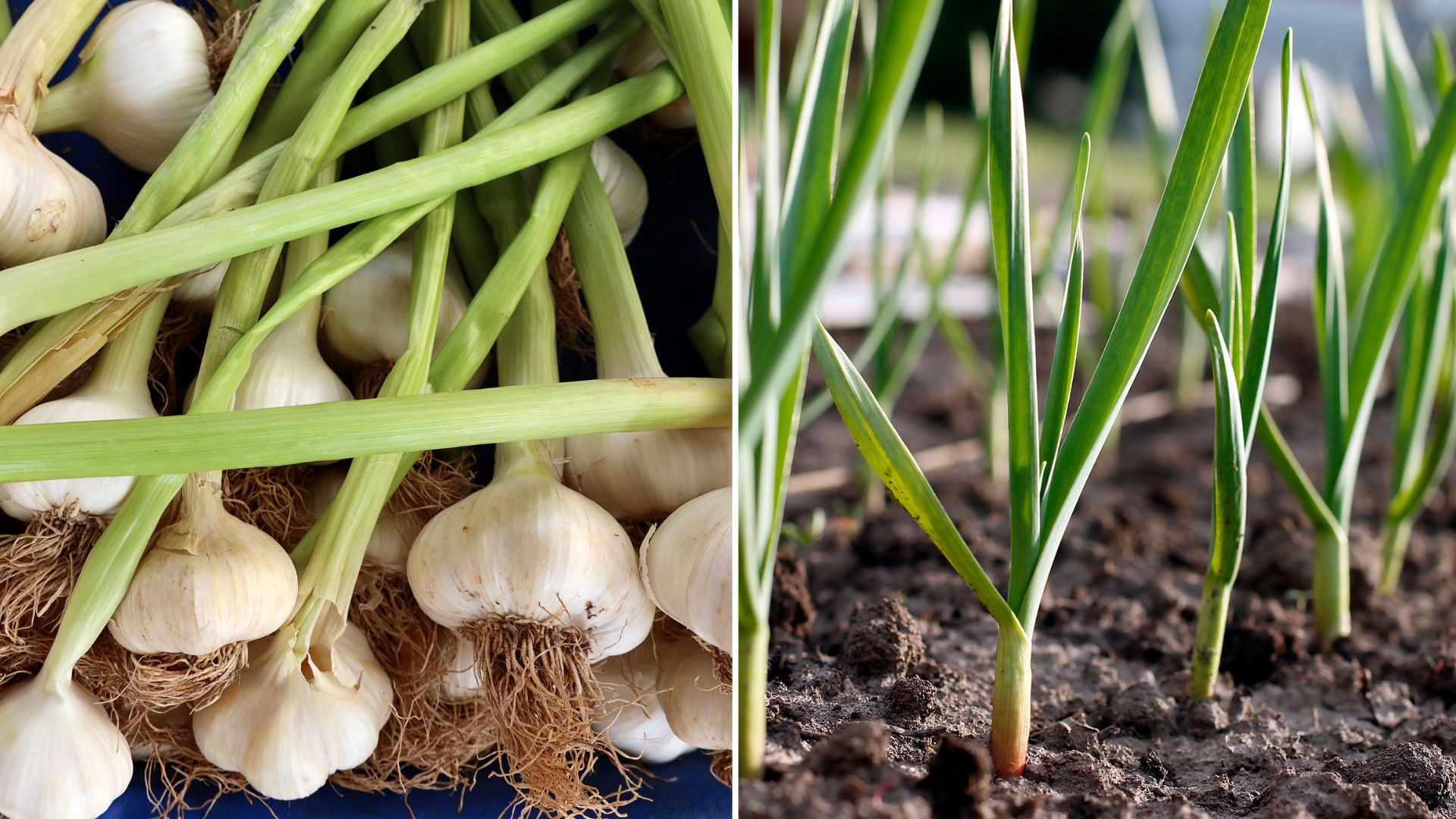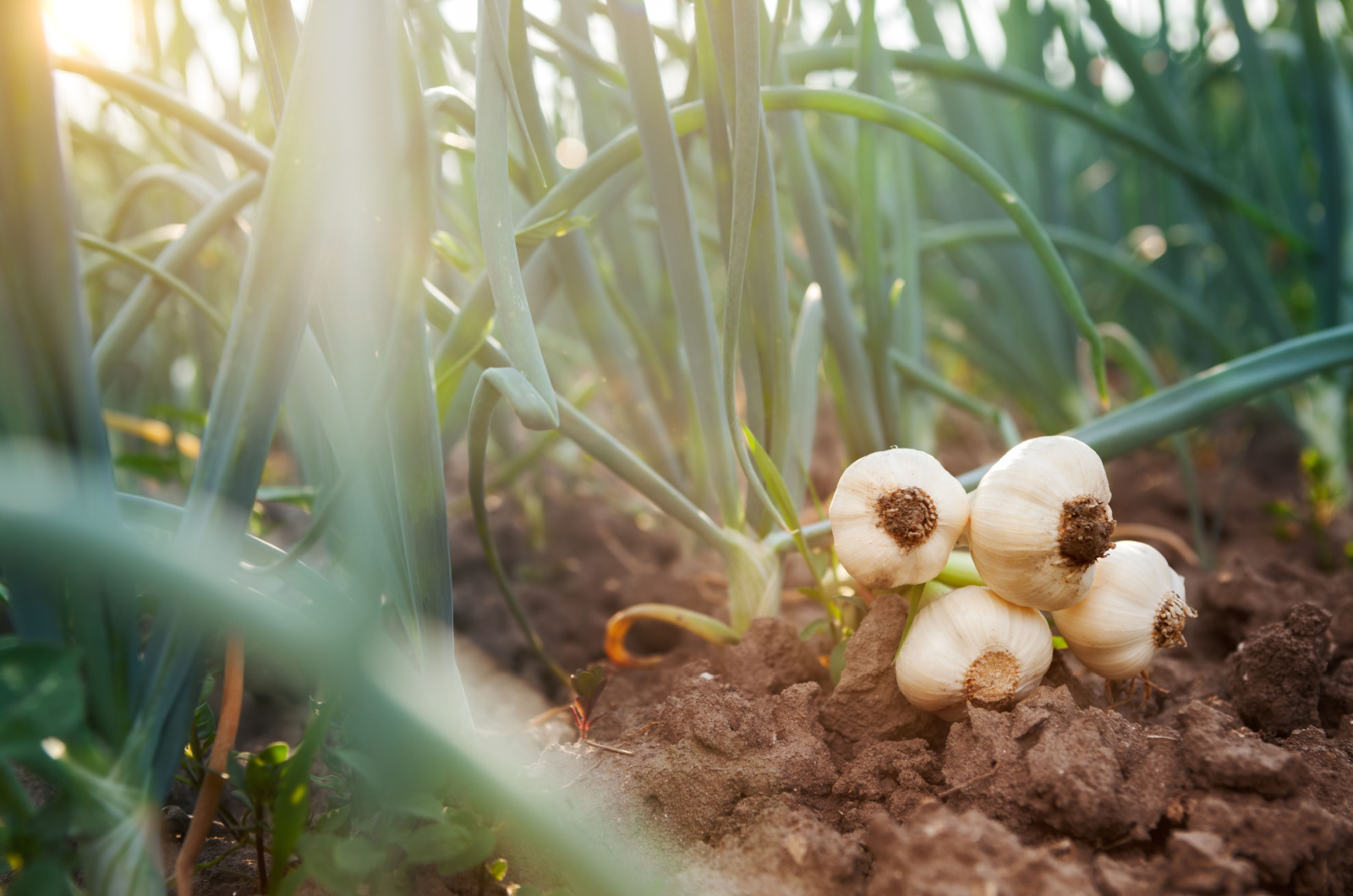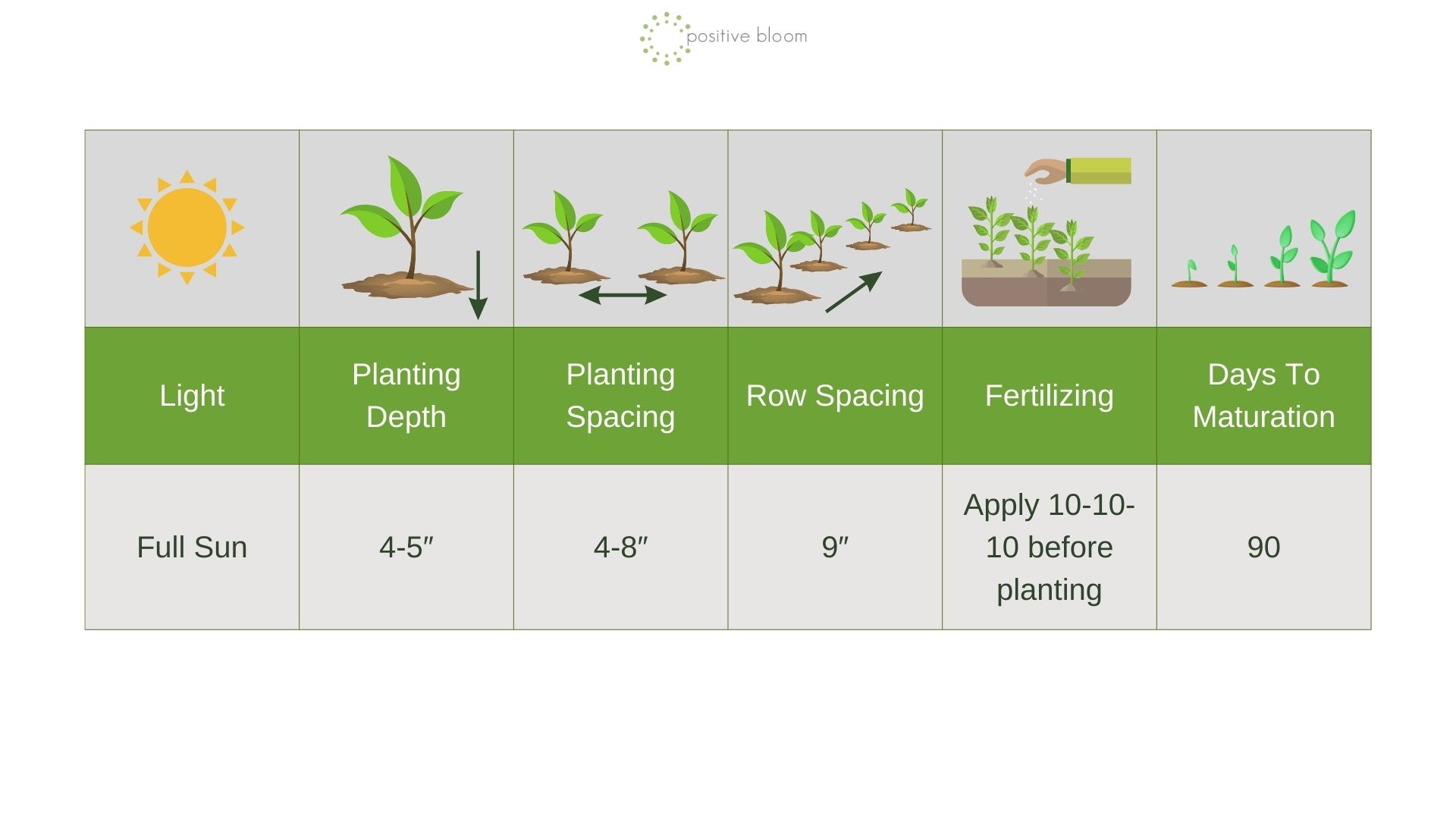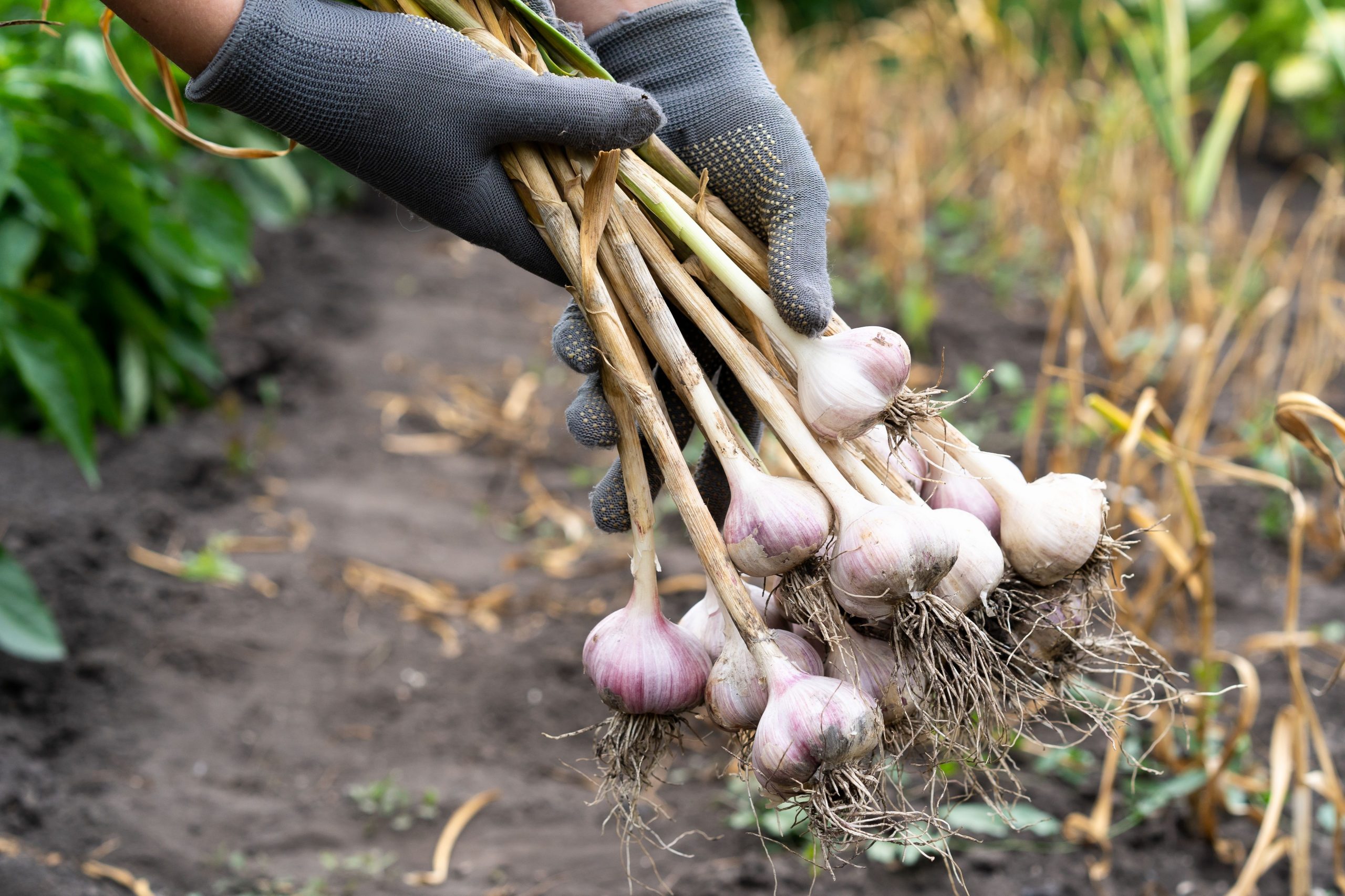Whenever someone asks me to recommend the easiest-to-grow veggies, garlic is one of the first plants that comes to my mind.
The best thing about these vegetables is their low susceptibility to pests and diseases. No matter if you’re a seasoned gardener or just starting out, you can have a bountiful garlic harvest with little effort.
Of course, there are some essential things you need to know about growing these plants and this article will cover them all.
So, let’s see everything, from choosing the best varieties to when to plant garlic for the best harvest!
Best Types Of Garlic To Grow
Generally speaking, garlic plants are divided into two main categories: hardneck and softneck.
The first ones are characterized by a stiff neck that is commonly referred to as a scape. It develops from the bulb’s center and is an edible plant part with a mild flavor.
The cloves of these garlic types are large and may last for 2-4 months when properly stored.
These varieties perform better in lower temperatures, so if you live in colder climates, they should be your first choice.
On the other hand, softneck varieties don’t generate scapes but their soft leaves can be braided after the bulb harvest. The shelves have a longer life cycle and when stored properly, they can last approximately 6-8 months after the harvest.
If you live in warmer climates where winters aren’t so harsh, you should go with softneck garlic types. However, some cultivars may grow well in the North so always check before you make the final decision.
There’s only one thing that remains to be discussed. If you’ve heard of elephant garlic, be aware that this isn’t a true type of garlic but rather a type of leek plant that generates cloves similar to those of garlic.
Can You Plant Store-bought Garlic?
When it comes to garlic found on the shelves of grocery stores, it may not be the best choice for planting.
The vast majority of store-bought garlic is mainly cultivated in California, so unless you live in a similar climate, you most likely won’t get a bountiful harvest.
Another essential thing to know is that garlic available in supermarkets is treated in order to prevent sprouting and has a bigger susceptibility to diseases.
I highly recommend purchasing bulbs from seed companies.
The Best Time To Plant Garlic
You can have an endless supply of garlic at home but it’s crucial to know when and how to plant it.
These plants perform best when planted in mid-fall i.e., from the middle of October to the beginning of December. The planting time mainly depends on your region and the first frost date.
Allium plants, including garlic, are among the spring bulbs that grow best when planted in fall.
The perfect time for planting is approximately three to six weeks before the first frost. It may be hard to determine the date but there’s nothing else to do except rely on the forecast.
Garlic is a hardy plant so don’t worry if some greenery protrudes from the ground.
A Guide To Planting Garlic
When selecting the planting site for your garlic, you should pay attention to sun exposure because a minimum of 6 hours of full sun is required for healthy development.
For best results, select a spot that receives 8 hours (the more, the better) of full sun daily.
These plants do well in poor soil types but from my experience, adding triple 10 fertilizer to the soil prior to planting ensures the healthiest garlic growth. If your bulbs have six cloves, you should prepare 5 tbsp of fertilizer, and so on.
The soil must be free-draining to prevent rotting in garlic roots. Even though garlic isn’t picky over the soil pH, it’s best to keep it between 6 and 7 to be safe.
Heavy clay or sandy soils don’t work well for this veggie, so if you have such soil, it would be best if you amended it with compost before planting.
The hole for each clove should be approximately 4-5 inches deep. Always divide the cloves from the bulb right before planting; simply remove the papery skin and separate the cloves.
Follow the rule of one clove per planting hole and make sure the pointy end faces upward.
Once your cloves are in the ground, cover them with about an inch of soil and gently pat it down.
Since there’s a risk of weed development on the planting site, you should apply a thin layer of mulch; straw works perfectly.
When planting your garlic, you need to pay attention to spacing; you should ensure a spacing of 9 inches between each row and leave a few inches between each clove.
Once the spring arrives, you should feed your garlic lightly to give it a nutrient boost. It’s also important to remove weeds if you spot any because garlic can’t compete for food and water.
Harvesting Garlic Scapes
Harvesting garlic scapes is another important part of the cultivation of these veggies. Hardneck varieties generate a long stem from the bulb’s center, and it typically occurs in early summer.
You should remove the stem as soon as you notice a tiny bud-like section growing towards the end of the curling stem.
It’s essential to cut off the scapes; according to the research of the University of Maine, if you leave them the size of the bulbs will reduce by up to 48%.
You can use the scapes in many delicious meals, such as pasta and frittatas.
Best Time To Harvest Garlic
The time that we’ve all been waiting for has finally arrived: the garlic harvest!
You should wait until the leaves that are the closest to the soil start to wither and become either yellow or brown.
It typically occurs at the beginning of summer, i.e., June to mid-July. However, your region plays the main role.
Waiting too long to harvest your garlic may cause issues with storage because papery skin can split and leave the cloves exposed. Your garlic won’t last as long as it should!
When harvesting, do not just pull, but rather dig out each bulb with a hand shovel or garden fork. Once the bulbs are out, shake them well to get rid of the excess soil and place them in a dark and cool place to cure.
Now remove the top section of the bulbs, leaving about an inch or two of the stem on the top. If you grow softneck varieties and plan on braiding them, skip this step.
Finally, store the bulbs in a cool and dry place, and if you accidentally nick any, consume them right away.
You can enjoy your garlic for months, depending on the type you originally planted. One more thing, don’t keep them in the fridge because they’ll lose their distinctive flavor.




